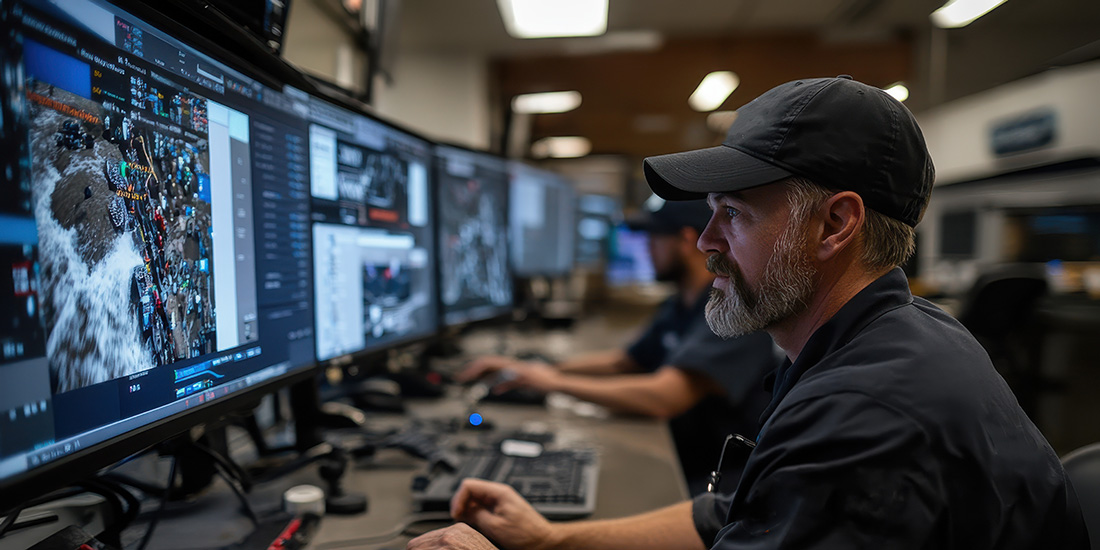Most recently published

Emergency Management of Tomorrow: Emerging Technologies and Concepts
Dan Cotter, Christina Bapst-Stump, Ann Lesperance and Rachel A. Bartholomew
December 11, 2024
More frequent and intense disasters put pressure on emergency managers and emergency operations centers to share and analyze data faster than ever before and with more reliability and defensibility. The future of emergency management is changing fast—and so is the science and technology to protect it.

From Today to Tomorrow: The Emergency Operations Center of the Future
Nick Betzsold and Grant Tietje
December 11, 2024
The next-generation EOC, which implements cutting-edge technology and AI, does not promise perfect disaster management, but it does mean responders at all levels will have better situational awareness, plan more efficiently, and act faster.

Advisory Board Spotlight: Interview with Caroline Agarabi, Ph.D.
Caroline Agarabi
December 4, 2024
What does it take to bridge science and strategy in the world of emergency preparedness? Caroline Agarabi, Ph.D., shares how her work shapes disaster response plans, supports lifesaving countermeasures, and prepares communities for the unexpected. Dive into her unique journey and insights in this compelling conversation.

Protecting Critical Infrastructure From Weaponized Drones
David Winks, Steve Chill, Frederick Ferrer, Michael J. "Apollo" Lovell, Mike Swearingen and Mary Lasky
December 4, 2024
Electricity substations are traditionally only protected by chain link fences and signage warning of the dangers of high voltage. However, this still leaves property vulnerable, especially to weaponized drones attacking from above, a mode of terrorism being used more extensively across the world and at home.

Editor’s Note: Giving Thanks for the Planners
Catherine L. Feinman
November 27, 2024
In this November edition of the Domestic Preparedness Journal, get a glimpse into securing New York City’s largest events. In addition, this month’s authors clarify the misconceptions and realities of human trafficking, explain why messaging matters, share about self-care during deployments, and warn of threats that communities across the country

Why Messaging Matters: A Regionalized Approach to Alerts and Warnings
Soraya Sutherlin
November 27, 2024
Effective, timely, and unified communication across jurisdictions is essential for saving lives. The 2015 ExxonMobil refinery explosion highlighted the urgent need for coordinated, cross-jurisdictional alerting. Emergency managers, public safety officials, and policymakers must come together to prioritize a fully integrated alerting system. It is no longer a luxury but a

The Nexus Between Major Events and Human Trafficking
Madeline Mann and Lindsey Lane
November 27, 2024
Most available data do not support the misconception that large-scale events lead to increased human trafficking. Rather, available evidence underscores a harsh truth: Human trafficking is a pervasive problem every day, not just when large events come to town.

A Violent Surge – Sovereign Citizens vs. Government Authority
Anthony (Tony) Mottola and Richard Schoeberl
November 20, 2024
The Federal Bureau of Investigation has classified the Sovereign Citizen movement as a domestic terrorist threat. To prepare law enforcement officials and other public safety agencies for the risks associated with this movement, agencies need to revise policies, procedures, and training to be more effective in handling encounters with extremist

Advice for Surviving a Disaster: Be Selfish and Small-Minded
David C. Williams II
November 13, 2024
In the base camp of his fifth federally declared disaster this year, a disaster finance coordinator reflects on a friend’s recent question: “How can I best help in a disaster?” His answer might be surprising: be selfish and small-minded.

A Look Behind Security Management at Two Iconic Holiday Celebrations
Inés Bebea
November 13, 2024
After the conclusion of a large-scale event, the planning for its next iteration starts again. If the public doesn’t notice emergency management’s moving parts during an event, it’s a success.

Advisory Board Spotlight: Interview with Robert DesRosier Sr.
Robert DesRosier Sr.
November 6, 2024
Robert DesRosier Sr., former director of Blackfeet Tribal Emergency Management and Homeland Security, discussed his journey into emergency management with Domestic Preparedness Journal editor Catherine Feinman. Beginning with his career as a first responder and his role in the Blackfeet Nation, he highlighted the importance of domestic preparedness and

Growing Foreign Threats to National Security, Part 2: Emergency Management Approaches and Choices
Glen Woodbury
October 30, 2024
This is Part 2 of a two-part article that explores the nation-state threat and its implications for the emergency management community regarding the operations, resilience, resourcing, strategies, and policies necessary to better prepare for future events.

Opportunities for Artificial Intelligence in Emergency Management
Alex Hagen and Jonathan (Jon) Barr
December 18, 2024
Recent research into the relationship between AI and emergency management uncovered an environment prepared for AI-based solutions. While AI must overcome some infrastructure hurdles, technologies to prevent, mitigate, and recover from emergencies are on the horizon.

Emergency Management of Tomorrow: Emerging Technologies and Concepts
Dan Cotter, Christina Bapst-Stump, Ann Lesperance and Rachel A. Bartholomew
December 11, 2024
More frequent and intense disasters put pressure on emergency managers and emergency operations centers to share and analyze data faster than ever before and with more reliability and defensibility. The future of emergency management is changing fast—and so is the science and technology to protect it.

From Today to Tomorrow: The Emergency Operations Center of the Future
Nick Betzsold and Grant Tietje
December 11, 2024
The next-generation EOC, which implements cutting-edge technology and AI, does not promise perfect disaster management, but it does mean responders at all levels will have better situational awareness, plan more efficiently, and act faster.

Advisory Board Spotlight: Interview with Caroline Agarabi, Ph.D.
Caroline Agarabi
December 4, 2024
What does it take to bridge science and strategy in the world of emergency preparedness? Caroline Agarabi, Ph.D., shares how her work shapes disaster response plans, supports lifesaving countermeasures, and prepares communities for the unexpected. Dive into her unique journey and insights in this compelling conversation.

Protecting Critical Infrastructure From Weaponized Drones
David Winks, Steve Chill, Frederick Ferrer, Michael J. "Apollo" Lovell, Mike Swearingen and Mary Lasky
December 4, 2024
Electricity substations are traditionally only protected by chain link fences and signage warning of the dangers of high voltage. However, this still leaves property vulnerable, especially to weaponized drones attacking from above, a mode of terrorism being used more extensively across the world and at home.

Editor’s Note: Giving Thanks for the Planners
Catherine L. Feinman
November 27, 2024
In this November edition of the Domestic Preparedness Journal, get a glimpse into securing New York City’s largest events. In addition, this month’s authors clarify the misconceptions and realities of human trafficking, explain why messaging matters, share about self-care during deployments, and warn of threats that communities across the country

Why Messaging Matters: A Regionalized Approach to Alerts and Warnings
Soraya Sutherlin
November 27, 2024
Effective, timely, and unified communication across jurisdictions is essential for saving lives. The 2015 ExxonMobil refinery explosion highlighted the urgent need for coordinated, cross-jurisdictional alerting. Emergency managers, public safety officials, and policymakers must come together to prioritize a fully integrated alerting system. It is no longer a luxury but a

The Nexus Between Major Events and Human Trafficking
Madeline Mann and Lindsey Lane
November 27, 2024
Most available data do not support the misconception that large-scale events lead to increased human trafficking. Rather, available evidence underscores a harsh truth: Human trafficking is a pervasive problem every day, not just when large events come to town.

A Violent Surge – Sovereign Citizens vs. Government Authority
Anthony (Tony) Mottola and Richard Schoeberl
November 20, 2024
The Federal Bureau of Investigation has classified the Sovereign Citizen movement as a domestic terrorist threat. To prepare law enforcement officials and other public safety agencies for the risks associated with this movement, agencies need to revise policies, procedures, and training to be more effective in handling encounters with extremist

Advice for Surviving a Disaster: Be Selfish and Small-Minded
David C. Williams II
November 13, 2024
In the base camp of his fifth federally declared disaster this year, a disaster finance coordinator reflects on a friend’s recent question: “How can I best help in a disaster?” His answer might be surprising: be selfish and small-minded.

A Look Behind Security Management at Two Iconic Holiday Celebrations
Inés Bebea
November 13, 2024
After the conclusion of a large-scale event, the planning for its next iteration starts again. If the public doesn’t notice emergency management’s moving parts during an event, it’s a success.

Advisory Board Spotlight: Interview with Robert DesRosier Sr.
Robert DesRosier Sr.
November 6, 2024
Robert DesRosier Sr., former director of Blackfeet Tribal Emergency Management and Homeland Security, discussed his journey into emergency management with Domestic Preparedness Journal editor Catherine Feinman. Beginning with his career as a first responder and his role in the Blackfeet Nation, he highlighted the importance of domestic preparedness and
Advisory Board Spotlight: Keeping It Real With Lynda Zambrano
Lynda Zambrano
October 30, 2024
Lynda Zambrano is on the advisory board for the Domestic Preparedness Journal. Lynda is the executive director of the Northwest Tribal Emergency Management Council and the National Tribal Emergency Management Council, and has been inducted into the International Association of Women in Emergency Management’s Hall of Fame. She sat down with
Growing Foreign Threats to National Security, Part 1: Challenges and Considerations
Glen Woodbury
October 23, 2024
Part 1 of a two-part series explores the nation-state threat and its implications for the emergency management community, regarding the operations, resilience, resourcing, strategies, and policies necessary to better prepare for future events.
The Ethics of Data in Disaster Management and Crisis Operations
Anthony S. Mangeri
October 23, 2024
As the demand for evidence-based decision-making continues to grow, emergency management professionals must commit to ethical data practices that respect the needs of the community and the rights of individuals. In times of crisis, data can save lives, but only if managed with care, responsibility, and respect for ethical principles.
Advisory Board Spotlight: Interview with Ray Barishansky, DrPH
Raphael M. Barishansky
October 23, 2024
Ray Barishansky, DrPH, is on the advisory board for the Domestic Preparedness Journal and has a passion for public health and emergency management. He sat down with the Journal’s Nicolette Casey to share his story. Learn about Dr. Barishansky’s journey from an EMT to a Doctor of Public Health.
Cyber and Physical Resilience in the Food and Agriculture Industry
Nathan DiPillo
October 16, 2024
Despite low profit margins and major setbacks caused by natural hazards and disasters, the food and agriculture sector continues to find innovative solutions. Balancing and integrating new concepts and technological advancements with an old-school farming mentality will keep this sector resilient and thriving when battling cyber and environmental threats.
Backyard Cybersecurity: The Local Challenge
Brian Shajari
October 16, 2024
The modern world increasingly relies on rapidly advancing digital technology, and cybercriminals progressively focus on ways to exploit technology’s vulnerabilities. Although higher levels of government and businesses may possess the tools necessary to protect against cyberattacks, local governments often do not.
Malicious and Non-Malicious Cyber Incidents: Education and Preparation
Dan Scherr and Tanya M. Scherr
October 9, 2024
Working with stakeholders across an organization to ensure cyber resilience is a part of disaster planning. Education is critical. Helping users understand hackers’ strategies to compromise an organization is foundational, and forward-looking efforts can help prevent oversights or critical failures during larger events.
Tren de Aragua: From Prison Gang to Transnational Organized Crime Syndicate in the U.S.
Anthony (Tony) Mottola and Dan Scherr
October 2, 2024
The United States has never been shielded from transnational organized crime syndicates or transnational street gangs operating in its borders. But these days, extensive and additional technology are needed across federal, state, and local agencies. Moreover, combating these organizations will require better collaboration and coordination among partner agencies as well
Securing Cities: The Fight Against Local Level Cyberthreats
Michael Breslin
October 2, 2024
As digital threats against local governments and private entities grow more sophisticated, the need for action becomes urgent. Cybersecurity is a shared responsibility, and at the local level, it forms the bedrock of the collective digital safety and security for all. Every citizen, agency, and organization must play a part
Preparedness – The Goal With No Finish Line
Catherine L. Feinman
September 25, 2024
In memory of the September 11 terrorist attacks and National Preparedness Month, the authors in this September edition of the Domestic Preparedness Journal address community outreach, responder fatigue, first responder equipment, crisis communications, and threat awareness.
Thwarting Terrorist Threats at Home
Richard Schoeberl
September 25, 2024
Although the U.S. has not experienced another terrorist attack like the one on September 11, 2001 (9/11), the threat remains. In fact, the Federal Bureau of Investigation has warned that the danger of an Islamic extremist-inspired terrorist attack inside the country is at the highest point since 9/11. Learn how
National Laboratory Partnerships: Linking Operations and Research
Ryan Eddy and Ann Lesperance
September 25, 2024
The September 11 terrorist attacks in 2001 spurred a pivotal change in the way the U.S. approaches preparedness for threats to the homeland. In recognition of National Preparedness Month, the Pacific Northwest National Laboratory showcases how national laboratories address homeland security threats by developing the technology and other resources first
Follow Us
Get Instant Access
Subscribe today to Domestic Preparedness and get real-world insights for safer communities.


